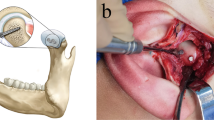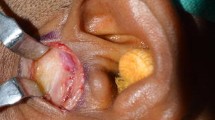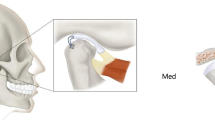Abstract
Objectives
To evaluate the effectiveness of arthroscopic reduction and rigid fixation (ARRF) using a suture-free titanium screw as a treatment approach to temporomandibular joint’s (TMJ) anterior disc displacement without reduction (ADDwoR) and assess its impact on clinical outcomes, including improvements in symptoms related to TMJ disorders.
Materials and methods
A series of twenty patients presented to the Department of Orthognathic and Temporomandibular Surgery at West China Hospital of Stomatology between September 2022 and January 2023, complaining of symptoms such as pain, clicking, and limited mouth opening. Standard magnetic resonance image (MRI) imaging T1 and T2 sequences in both sagittal and coronal views study with closed and maximal open mouth positions were taken preoperatively to assess the disc’s position, integrity, and shape. Also, cone-beam computed tomography (CBCT) scans images to find any degenerative changes and evaluate the condylar bone’s features and volume. Additionally, the clinical examination assesses limited oral opening, mechanical pain, and the presence of any noises such as clicking and crepitus. All cases were treated under general anesthesia using the arthroscopic release, reduction, and rigid fixation of the TMJ’s ADDwoR to establish a normal disc-condyle relationship and to restore the functional position.
Results
Patients’ symptoms, such as pain and mouth opening, improved significantly following the arthroscopic treatment. Postoperative MRI and CBCT imaging follow-up conducted at 6 months demonstrated the stable position of the reduced TMJ disc and the fixation screw. Notably, none of the patients exhibited signs of relapse during this follow-up period.
Conclusion
Overall, the ARRF of TMJ’s ADDwoR using a suture-free titanium screw proved to be safe and provides satisfactory results, in addition to the several advantages of using suture-free titanium screws, such as biocompatibility, strong fixation, and durability. However, it is a technically demanding procedure requiring extensive, long-term training.
Clinical relevance
ARRF using a cost-effective fixation titanium screw to treat ADDwoR emerges as a clinically effective minimally invasive approach.




Similar content being viewed by others
References
Liu X, Zheng J, Cai X, Abdelrehem A, Yang C (2019) Techniques of Yang’s arthroscopic discopexy for temporomandibular joint rotational anterior disc displacement. Int J Oral Maxillofac Surg 48:769–778. https://doi.org/10.1016/j.ijom.2018.12.003
Lin W-C, Lo C-P, Chiang I-C, Hsu C-C, Hsu W-L, Liu D-W, Juan Y-H, Liu G-C (2012) The use of pseudo-dynamic magnetic resonance imaging for evaluating the relationship between temporomandibular joint anterior disc displacement and joint pain. Int J Oral Maxillofac Surg 41:1501–1504
Alomar X, Medrano J, Cabratosa J, Clavero JA, Lorente M, Serra I, Monill JM, Salvador A (2007) Anatomy of the temporomandibular joint. Semin Ultrasound CT MR 28:170–183. https://doi.org/10.1053/j.sult.2007.02.002
Morrow D, Tallents RH, Katzberg RW, Murphy WC, Hart TC (1996) Relationship of other joint problems and anterior disc position in symptomatic TMD patients and in asymptomatic volunteers. J Orofac Pain 10:15–20
Baldwin AJ, Cooper JC (2004) Eminectomy and plication of the posterior disc attachment following arthrotomy for temporomandibular joint internal derangement. J Craniomaxillofac Surg 32:354–359. https://doi.org/10.1016/j.jcms.2004.05.003
Tang L, Bai X, Wang Y, Chen Y, Chen M-e, Xia C, Li Z (2023) Effect of TMJ disc position on condylar bone remodeling after arthroscopic disc repositioning surgery. Eur J Radiol 169:111189. https://doi.org/10.1016/j.ejrad.2023.111189
Goizueta-Adame CC, Pastor-Zuazaga D, Bañón JEO (2014) Arthroscopic disc fixation to the condylar head. Use of resorbable pins for internal derangement of the temporomandibular joint (stage II–IV). Preliminary report of 34 joints. J Cranio-Maxillofac Surg 42:340–346
Yang C, Cai X-Y, Chen M-J, Zhang S-Y (2012) New arthroscopic disc repositioning and suturing technique for treating an anteriorly displaced disc of the temporomandibular joint: part I–technique introduction. Int J Oral Maxillofac Surg 41:1058–1063
Goizueta Adame CC, Muñoz-Guerra MF (2012) The posterior double pass suture in repositioning of the temporomandibular disc during arthroscopic surgery: a report of 16 cases. J Craniomaxillofac Surg 40:86–91. https://doi.org/10.1016/j.jcms.2011.01.022
Martín-Granizo R, González-García R (2022) Arthroscopic disc repositioning techniques of the temporomandibular joint part 2: resorbable pins. Atlas Oral Maxillofac Surg Clin North Am 30:185–191. https://doi.org/10.1016/j.cxom.2022.06.011
Ângelo DF, Sanz D, Cardoso HJ (2023) Bilateral arthroscopy of the temporomandibular joint: clinical outcomes and the role of a second intervention—a prospective study. Clin Oral Invest 27:6167–6176
Israel HA (1989) Technique for placement of a discal traction suture during temporomandibular joint arthroscopy. J Oral Maxillofac Surg 47:311–313. https://doi.org/10.1016/0278-2391(89)90240-1
McCain JP, Podrasky AE, Zabiegalski NA (1992) Arthroscopic disc repositioning and suturing: a preliminary report. J Oral Maxillofac Surg 50:568–579
Adame CCG, Muñoz-Guerra MF (2012) The posterior double pass suture in repositioning of the temporomandibular disc during arthroscopic surgery: a report of 16 cases. J Cranio-Maxillofac Surg 40:86–91
Kiringoda R, Kozin ED, Lee DJ (2016) Outcomes in endoscopic ear surgery. Otolaryngol Clin North Am 49:1271–1290. https://doi.org/10.1016/j.otc.2016.05.008
Montgomery MT, Van Sickels JE, Harms SE, Thrash WJ (1989) Arthroscopic TMJ surgery: effects on signs, symptoms, and disc position. J Oral Maxillofac Surg 47:1263–1271
Murakami K (2013) Rationale of arthroscopic surgery of the temporomandibular joint. J Oral Biol Craniofac Res 3:126–134. https://doi.org/10.1016/j.jobcr.2013.07.002
Gaete C, Droguett C, Sáez F, Astorga P (2023) Clinical and demographic factors associated with the effectiveness of temporomandibular joint arthroscopy. Oral Maxillofac Surg. https://doi.org/10.1007/s10006-023-01158-2
Zhang W, Luo Y, Abdelrehem A, Liu X, Chen M, Yang C, Yu C, Wang F (2023) Arthroscopic disk repositioning after failed open disk repositioning. J Craniofac Surg 34:e129–e134
Ohnuki T, Fukuda M, Iino M, Takahashi T (2003) Magnetic resonance evaluation of the disk before and after arthroscopic surgery for temporomandibular joint disorders. Oral Surg Oral Med Oral Pathol Oral Radiol Endod 96:141–148. https://doi.org/10.1016/s1079-2104(03)00346-9
Kondoh T, Hamada Y, Kamei K, Seto K (2003) Simple disc reshaping surgery for internal derangement of the temporomandibular joint: 5-year follow-up results. J Oral Maxillofac Surg 61:41–48. https://doi.org/10.1053/joms.2003.50007
Marlière DAA, Vicentin Calori MJA, Medeiros YdL, Santiago RC, Strujak G, Asprino L (2023) Clinical outcomes of the discopexy using suture anchors for repositioning disc displacement in temporomandibular joints: systematic review and meta-analysis. J Cranio-Maxillofac Surg 51:475–484. https://doi.org/10.1016/j.jcms.2023.06.007
Wang P, Liu Y, Bi R, Jiang N, Telha W, Cao P, Zhu S (2023) TMJ anterior disc displacement anchorage surgery: a retrospective study based on a suture-free titanium screw strategy. Clin Oral Investig 27(8):4579–4584. https://doi.org/10.1007/s00784-023-05083-2
Funding
This study was supported by the National Natural Science Foundation of China (NSFC) under grant number 82071139 and the Key Research and Development Program of the Sichuan Provincial Department of Science and Technology under grant number 23ZDYF2130.
Author information
Authors and Affiliations
Contributions
Yao Liu: Conceptualization, Patient treatment, Data curation, original draft preparation, review, and editing.
Peng Wang: Conceptualization, Patient treatment, Data curation, review and editing.
Wael Telha: Conceptualization, Patient treatment, original draft preparation, review, and editing.
Ruiye Bi: Conceptualization, Patient treatment, original draft preparation, review, and editing.
Nan Jiang: Conceptualization, Patient treatment, original draft preparation, review, and editing.
Songsong Zhu: Project administration, Reviewing and Editing, Supervision.
Y.L: conceptualization, patient treatment, data curation, original draft preparation, review, and editing. P.W: conceptualization, patient treatment, data curation, review and editing. W.T: conceptualization, patient treatment, original draft preparation, review and editing. R.B: conceptualization, patient treatment, original draft preparation, review and editing. N.J: conceptualization, patient treatment, original draft preparation, review and editing. S.Z: project administration, reviewing and editing, supervision.
Corresponding author
Ethics declarations
Competing interests
The authors declare no competing interests.
Conflict of interest
All authors declare that there is no conflict of interest regarding the publication of this paper.
Ethical approval
This study was conducted in compliance with the Declaration of Helsinki and was approved by the regional ethics review board of West China Hospital of Stomatology (WCHSIRB-CT-2022–375).
Consent to participate
Written informed consent was obtained from all individual participants involved in the study.
Additional information
Publisher's Note
Springer Nature remains neutral with regard to jurisdictional claims in published maps and institutional affiliations.
Supplementary Information
Below is the link to the electronic supplementary material.
Supplementary file1 (MP4 418435 KB)
Rights and permissions
Springer Nature or its licensor (e.g. a society or other partner) holds exclusive rights to this article under a publishing agreement with the author(s) or other rightsholder(s); author self-archiving of the accepted manuscript version of this article is solely governed by the terms of such publishing agreement and applicable law.
About this article
Cite this article
Liu, Y., Wang, P., Telha, W. et al. Arthroscopic reduction and rigid fixation of the anteriorly displaced temporomandibular joint disc without reduction using titanium screw: a case series. Clin Oral Invest 28, 156 (2024). https://doi.org/10.1007/s00784-024-05552-2
Received:
Accepted:
Published:
DOI: https://doi.org/10.1007/s00784-024-05552-2




